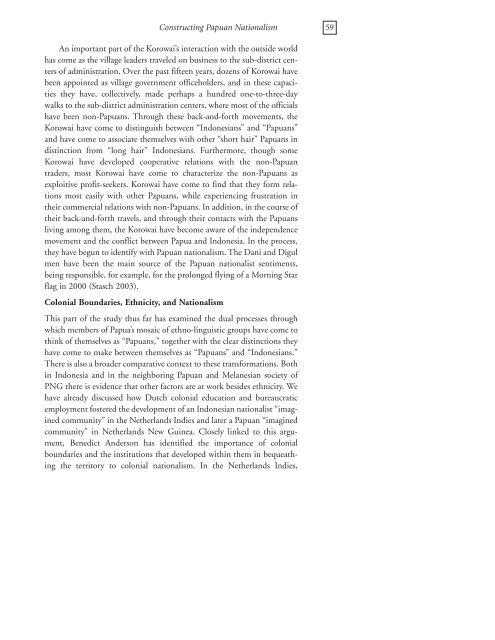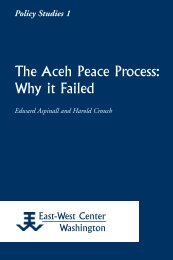Constructing Papuan Nationalism: History, Ethnicity ... - ScholarSpace
Constructing Papuan Nationalism: History, Ethnicity ... - ScholarSpace
Constructing Papuan Nationalism: History, Ethnicity ... - ScholarSpace
- No tags were found...
Create successful ePaper yourself
Turn your PDF publications into a flip-book with our unique Google optimized e-Paper software.
<strong>Constructing</strong> <strong>Papuan</strong> <strong>Nationalism</strong> 59An important part of the Korowai’s interaction with the outside worldhas come as the village leaders traveled on business to the sub-district centersof administration. Over the past fifteen years, dozens of Korowai havebeen appointed as village government officeholders, and in these capacitiesthey have, collectively, made perhaps a hundred one-to-three-daywalks to the sub-district administration centers, where most of the officialshave been non-<strong>Papuan</strong>s. Through these back-and-forth movements, theKorowai have come to distinguish between “Indonesians” and “<strong>Papuan</strong>s”and have come to associate themselves with other “short hair” <strong>Papuan</strong>s indistinction from “long hair” Indonesians. Furthermore, though someKorowai have developed cooperative relations with the non-<strong>Papuan</strong>traders, most Korowai have come to characterize the non-<strong>Papuan</strong>s asexploitive profit-seekers. Korowai have come to find that they form relationsmost easily with other <strong>Papuan</strong>s, while experiencing frustration intheir commercial relations with non-<strong>Papuan</strong>s. In addition, in the course oftheir back-and-forth travels, and through their contacts with the <strong>Papuan</strong>sliving among them, the Korowai have become aware of the independencemovement and the conflict between Papua and Indonesia. In the process,they have begun to identify with <strong>Papuan</strong> nationalism. The Dani and Digulmen have been the main source of the <strong>Papuan</strong> nationalist sentiments,being responsible, for example, for the prolonged flying of a Morning Starflag in 2000 (Stasch 2003).Colonial Boundaries, <strong>Ethnicity</strong>, and <strong>Nationalism</strong>This part of the study thus far has examined the dual processes throughwhich members of Papua’s mosaic of ethno-linguistic groups have come tothink of themselves as “<strong>Papuan</strong>s,” together with the clear distinctions theyhave come to make between themselves as “<strong>Papuan</strong>s” and “Indonesians.”There is also a broader comparative context to these transformations. Bothin Indonesia and in the neighboring <strong>Papuan</strong> and Melanesian society ofPNG there is evidence that other factors are at work besides ethnicity. Wehave already discussed how Dutch colonial education and bureaucraticemployment fostered the development of an Indonesian nationalist “imaginedcommunity” in the Netherlands Indies and later a <strong>Papuan</strong> “imaginedcommunity” in Netherlands New Guinea. Closely linked to this argument,Benedict Anderson has identified the importance of colonialboundaries and the institutions that developed within them in bequeathingthe territory to colonial nationalism. In the Netherlands Indies,
















